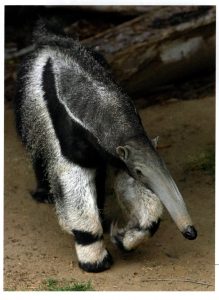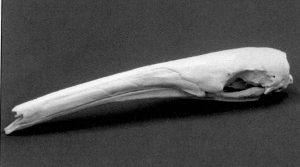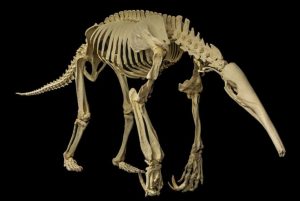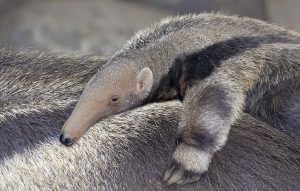If it was determined that there needed to be an animal engineered to provide a check on termites and other similar insects, would it be possible to imagine an improvement over the giant anteater? Would it be possible to realistically imagine modifications to the designs of other existing or extinct animals in order to meet the desired goals?
Armadillos and pangolins are animals that also have a diet similar to anteaters. That is, they like to eat insects like termites and ants. However, there are clearly large differences between armadillos, pangolins, and the giant anteater. In this article we are not focused on armadillos and pangolins, but we will take a closer look at the incredible giant anteater (Myrmecophaga tridactyla).
Giant anteaters are amazing and unique. There is no other animal outside their family* quite like them. They live in South and Central America. They like grassland, swamps, and lowland tropical forests. They grow to be six to eight feet long and 50 to 90 pounds, with males 10 to 20 per cent heavier than females.
Giant Anteater at the San Diego Zoo
The first thing that one notices about the animal is its unusual long slender snout. Its mouth is quite small and only opens to a small oval. Its foot-long and toothless head is almost tubular in shape. Its 12 to 24 inch-long tongue is longer than its head and is covered in tiny, posteriorly directed spines. It has salivary glands that secrete a thick, sticky saliva that coats its tongue. All of this design works flawlessly to convey a load of insects through its mouth into its stomach.
Giant Anteater Skull
The anteater does not have a stomach that secretes hydrochloric acid as is common in mammals. Instead for the anteater its stomach is designed to incorporate the formic acid content of the insects that it eats for the digestive process.
The giant anteater has powerful forearms and sharp claws that it uses to rip open termite and ant nests. With a sense of smell some forty times better than a human, it can detect its food from a considerable distance. Once a nest is located the anteater rapidly goes to work. Usually a small hole is dug into the nest, and the anteater licks up the insects as they emerge. Its tongue moves rapidly in and out at a rate of up to 150 slurps a minute, taking larvae and cocoons as well as insects. The incoming nourishment is crushed against the hard palate before being swallowed. The complex reciprocating mouth operation is unique in the animal kingdom and is unsurpassed for the rate of insect food intake. Giant anteaters are choosy about the type of ants and termites that they will consume. They avoid eating the aggressive soldier types of ants and termites that have large jaws.
The four-inch-long claws on the front feet are kept sharp by the orientation of its toes flexed to the side when walking. The giant anteater can climb trees but does this only infrequently. It has a coarse, stiff, dense coat that is colored gray with a black-and-white shoulder stripe.
Giant Anteater Skeleton
I think it interesting that anteaters utilize each nest for only a short time, taking less than 200 insects each feeding. They cause little permanent damage to nests and move on from nest to nest to get their daily food requirement of up to 35,000 insects a day. This fact points toward an instinct designed for the conservation of the food source to the advantage of the insects as well as the anteaters.
Giant anteaters are generally solitary but do manage to mate in the fall, and a single youngster is born in the spring. The young are precocious and are born with sharp claws that allow them to climb onto their mother’s back. The youngling may continue to ride around on its mother’s back for up to a year. This commonly ensues even though the weaning stage occurs at about six months. Sexual maturity is reached at about two years of age.
Baby Giant Anteater Riding on its Mother’s back
All anteaters have low metabolic rates, and giant anteaters have the lowest recorded body temperature for a placental mammal of only 90.9° F. Giant anteaters scoop out shallow depressions in which they rest for up to fifteen hours a day. They stay hidden by covering themselves with their huge fan-like tail.
Giant Anteater Showing its Large Tail
In conclusion, it is difficult for me to imagine how any animal could be better engineered to perform the function of checking the population of ants and termites. If evolution is the reason for the existence of this marvelous animal, ask yourself, what did it evolve from and how could this ever happen? No, I think we must thank God for this creation of the giant anteater!
*Created Kind Information for Anteaters:
Only two other members are currently assigned to the Myrmecophagidae family:
1. Tamandua (Tamandua Mexicana and Tamandua tetradactyla).
2. Silky anteater (Cyclopes diactylus).
J.D. Mitchell







